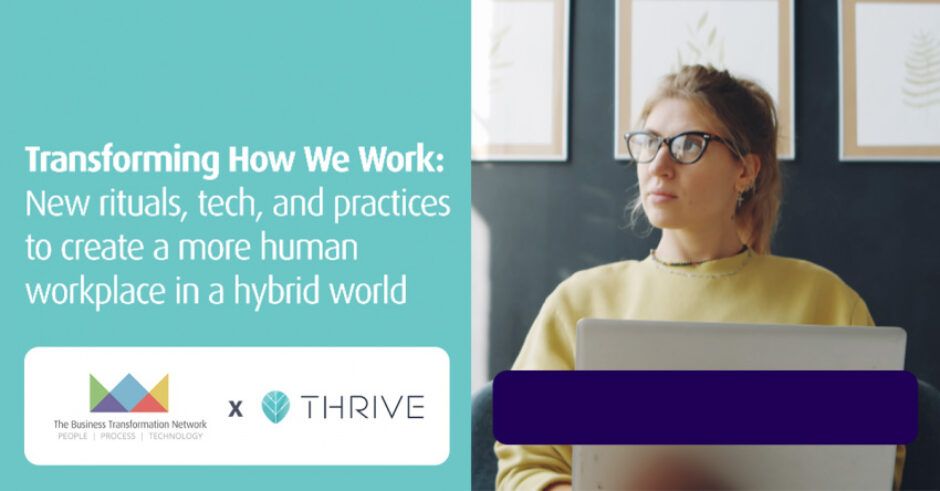The role of mental health in the workplace has become one of the most pertinent conversations of late with organisations starting to really see helping employee mental health as less of a nice to have and more of a must-have.
The BTN was recently delighted to partner with Thrive Global for a fascinating roundtable with People leaders from across the USA around transforming how we work and finding the balance between work and productivity in a safe workplace. The session was hosted by Joe Hubbard (Chief Training Officer at Thrive Global) and Dennis Kyle (CEO at Positive Results).
Be Human and Connect – Don’t forget to be authentic
Mental health is quite often overlooked within organisations but step 1 must be to educate our leaders. We need to teach our leaders how to be compassionate and have the power of connection and show that they care.
The group spoke about the benefit of activating wellness champions across the business, not just within the leadership team, as a way to understand the mental health of our employees. Role modelling is critical to eliminate stigmas and our leaders must have energy, effectiveness and enthusiasm towards wanting to make a change. The more you can get the manager to do the role modelling will make a huge difference for the people that directly report to them. You have to be well to live well.
Joe discussed how performance massively improved when people feel psychologically safe and then feel that they matter within an organisation. The role of leadership and its impact on the business is sometimes intangible but the role of feedback is something that is becoming ever more important as younger generations can be embraced and have their resilience increased through a culture of feedback.
We can get our employees to come on the journey with us by asking the right questions. One of the leaders spoke about using a 321 method at the start of conversations. Use 3 minutes to ask about the good stuff, then focus on 2 goals that you should be aiming for then ask 1 question about 1 thing as a leader that they could do to either help the employee or let them lead. All of this results in an authentic and human conversation.
Focus on a business case
How can we determine whether people need support when it comes to their mental health?
One of the most talked about topics at the moment is still around the transition from an office-based working environment to a remote/hybrid one. There was a discussion about whether employees should return to the office and the reasons behind it. There was the statement made that referenced Adam Grant, Organisational Psychologist at Wharton, around the notion that if you are marathon running, you don’t need to run every day but if you are a basketball player, you do need to learn and try new things every day on the basketball court. We must look at the reason why we want to bring people into the office. What benefit do our employees get from being in the office? What happens if they come to the office? There is a real re-learning that needs to happen with regard to going back into the office.
Any mental health initiatives need to be implemented as part of a people strategy and instead of ticking them off as we go, we should be always aiming for a step further.
Technology is a good backstop but people are the focus
There was the comment around equity when it comes to the role of technology, whereby if there are people who are potentially undereducated or don’t use apps on phones, how can we ensure we are still giving them the same experience with their well-being if we have relied on technology as our portal for help?
There was a conversation about the role of connecting activities such as hours of sleep or dentist visits, which have a positive impact on your health, to reward and benefits programs. This concept of using technology as a facilitator creates a healthier, happier and more consistent workforce. The additional value of wellness fairs and the importance of them having a physical presence within an office environment induces visibility and education. Creating intentional downtime for our employees helps to facilitate people getting some of their ‘home life’ back.
Technology can only do so much for our organisations, our managers need to be asking the right questions and understanding if and when there are potential triggers for trauma. These are people’s focuses that we must bring back to the forefront.
When people are not around each other, they lose the diverse connection as they are only gaining 1 means of interaction through video. People, therefore, don’t feel a connection with anything. Mental health improves as a direct result of getting the boosts with people; when this doesn’t occur, we lose the muscle to be around others. People can feel that sometimes it is easier to not be around others but that doesn’t necessarily mean it is better. We must empower our employees to feel like they can.
About Thrive Global
Thrive’s mission is to unlock human potential by ending the stress and burnout epidemic. We offer companies and individuals sustainable, science-based solutions to enhance both mental and physical well-being and performance, purpose and relationship with technology. We are committed to accelerating this culture shift around the world.



